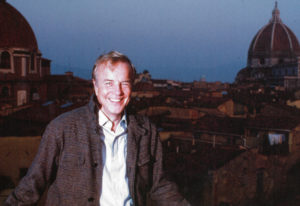2023 Zeffirelli Anniversary Celebrations

In honor of the 100th anniversary of Franco Zeffirelli’s birth, a series of events will celebrate his profound achievements in film and theater. On February 12, the public is invited to enjoy the range of commemorations and shows set up to shine a light on such an illustrious member of the Florentine community.
Born in Florence in 1923, Zeffirelli attended the Accademia di Belle Arti (Fine Arts Academy) and the University of Florence, where he began his pursuit of mastering the creativity behind the performing arts. He started as a set designer for Luchino Visconti in the early 1950s, and eventually, began directing his own productions, starting with Cinderella in 1954. He gained international fame with the film Romeo and Juliet (1968), and is also known for Who Killed Virginia Woolf? (1964), Jesus of Nazareth (1977), Othello (1972), and his partly autobiographical film, Tea with Mussolini (1999). His work goes beyond sheer beauty, as reflected in the documentary, Per Firenze (1966), which helped raised millions of dollars for relief and restoration efforts in Florence after the 1966 flood.
Zeffirelli’s iconic legacy encompasses his elaborate and polished set and costume designs, as well as his refined directorial prowess in all his films and theater productions. Although he lived most of his working life in Rome, Zeffirelli always saw Florence as his home. Therefore, he decided to establish and donate his legacy to a foundation that bears his name and is headquartered in Florence. This was meant to highlight his love for a city that his son Pippo describes as the core of his “spiritual and cultural inspiration.” The public can visit the Foundation in Piazza San Firenze to experience a grand collection of his intricate costume and set sketches, along with a variety of costumes, movie posters, and other mementos of Zeffirelli’s illustrious life.
For such a special occasion, the Franco Zeffirelli Foundations has teamed up with the City of Florence to organize a wide range of events to honor Zeffirelli. The public is welcome to attend the festivities scheduled on what would have been his 100th birthday on Sunday, February 12. The program is as follows.
9:30 am: at San Miniato’s Porte Sante cemetery, Father Bernardo will bless Zeffirelli’s burial spot to begin the beautiful day.
10 am: the city of Florence will commemorate Zeffirelli with an official ceremony that will give his name to a vantage point and a garden after him located just below Piazzale Michelangelo.
10:30 am: the Frecce Tricolori, a squadron of the Italian Air Force, will perform an airshow and leave a trail of colors symbolizing the Italian flag in tribute to Zeffirelli’s heritage. The best view to watch this demonstration would be from Piazzale Michelangelo.
3 pm: a new postage stamp commemorating Zeffirelli will be presented, and the Foundation will also unveil an exhibition of postage stamps issued over the years designed to keep the memory the master alive.
5 pm: the Calabria Philharmonic Orchestra and the Sicilian Lyrical Choir will offer a free concert entitled, “For Franco Zeffirelli,” in the Zeffirelli Foundation Music Room to end the celebratory day. The event can be enjoyed by the public with a booking in advance.
10 am – 12 noon, 3 – 6 pm: the Foundation will be open for tours which are free to residents of the greater Florence metropolitan area with a photo ID. The museum includes a Zeffirelli’s sketches, production costumes and notes, along with personal memorabilia.
The producer who had an eye for detail, never failed to deliver alternative and impressive works. At the museum, his set design for Aida, performed in Tokyo (1998), portrays Egyptian characters dressed in tones of gold, silver and blue. Other techniques used were stencil designs, exhibited in Tosca (1985) on stage at the Met, and metallic gold foil used for his movie rendition of Hamlet (1990) after which he was said to be the first artist to use such technique. One of the most impressive rooms is dedicated solely to his storyboards in addition to a multimedia presentation of his interpretation of Dante’s Inferno, a work-in-progress which never achieved release. (Antoniette Damico)
